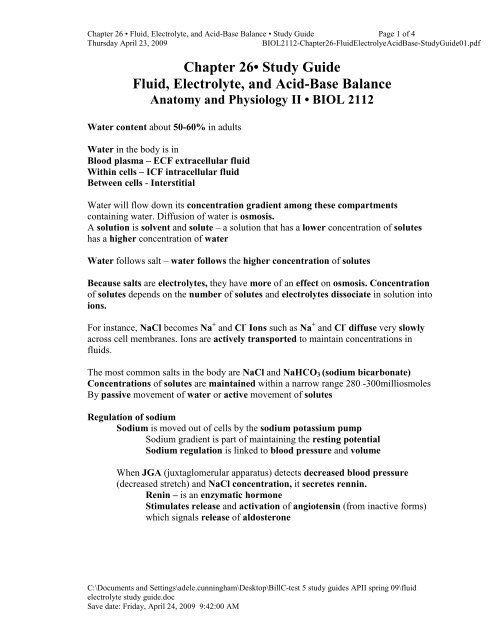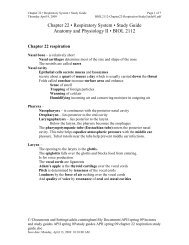Chapter 26⢠Study Guide Fluid, Electrolyte, and Acid-Base Balance ...
Chapter 26⢠Study Guide Fluid, Electrolyte, and Acid-Base Balance ...
Chapter 26⢠Study Guide Fluid, Electrolyte, and Acid-Base Balance ...
- No tags were found...
You also want an ePaper? Increase the reach of your titles
YUMPU automatically turns print PDFs into web optimized ePapers that Google loves.
<strong>Chapter</strong> 26 • <strong>Fluid</strong>, <strong>Electrolyte</strong>, <strong>and</strong> <strong>Acid</strong>-<strong>Base</strong> <strong>Balance</strong> • <strong>Study</strong> <strong>Guide</strong> Page 1 of 4Thursday April 23, 2009BIOL2112-<strong>Chapter</strong>26-<strong>Fluid</strong>Electrolye<strong>Acid</strong><strong>Base</strong>-<strong>Study</strong><strong>Guide</strong>01.pdf<strong>Chapter</strong> 26• <strong>Study</strong> <strong>Guide</strong><strong>Fluid</strong>, <strong>Electrolyte</strong>, <strong>and</strong> <strong>Acid</strong>-<strong>Base</strong> <strong>Balance</strong>Anatomy <strong>and</strong> Physiology II • BIOL 2112Water content about 50-60% in adultsWater in the body is inBlood plasma – ECF extracellular fluidWithin cells – ICF intracellular fluidBetween cells - InterstitialWater will flow down its concentration gradient among these compartmentscontaining water. Diffusion of water is osmosis.A solution is solvent <strong>and</strong> solute – a solution that has a lower concentration of soluteshas a higher concentration of waterWater follows salt – water follows the higher concentration of solutesBecause salts are electrolytes, they have more of an effect on osmosis. Concentrationof solutes depends on the number of solutes <strong>and</strong> electrolytes dissociate in solution intoions.For instance, NaCl becomes Na + <strong>and</strong> Cl - Ions such as Na + <strong>and</strong> Cl - diffuse very slowlyacross cell membranes. Ions are actively transported to maintain concentrations influids.The most common salts in the body are NaCl <strong>and</strong> NaHCO 3 (sodium bicarbonate)Concentrations of solutes are maintained within a narrow range 280 -300milliosmolesBy passive movement of water or active movement of solutesRegulation of sodiumSodium is moved out of cells by the sodium potassium pumpSodium gradient is part of maintaining the resting potentialSodium regulation is linked to blood pressure <strong>and</strong> volumeWhen JGA (juxtaglomerular apparatus) detects decreased blood pressure(decreased stretch) <strong>and</strong> NaCl concentration, it secretes rennin.Renin – is an enzymatic hormoneStimulates release <strong>and</strong> activation of angiotensin (from inactive forms)which signals release of aldosteroneC:\Documents <strong>and</strong> Settings\adele.cunningham\Desktop\BillC-test 5 study guides APII spring 09\fluidelectrolyte study guide.docSave date: Friday, April 24, 2009 9:42:00 AM
<strong>Chapter</strong> 26 • <strong>Fluid</strong>, <strong>Electrolyte</strong>, <strong>and</strong> <strong>Acid</strong>-<strong>Base</strong> <strong>Balance</strong> • <strong>Study</strong> <strong>Guide</strong> Page 2 of 4Thursday April 23, 2009BIOL2112-<strong>Chapter</strong>26-<strong>Fluid</strong>Electrolye<strong>Acid</strong><strong>Base</strong>-<strong>Study</strong><strong>Guide</strong>01.pdfAldosteroneAbout 90% of sodium is reabsorbed by kidney tubules at proximal tubule <strong>and</strong>ascending loop of HenleAldosterone affects the other 10% in the distal convoluted tubule <strong>and</strong>collecting tubulesWhen aldosterone is high essentially all sodium is reabsorbed <strong>and</strong>water follows saltANPAtrial naturietic peptide is secreted by the heart in response to stretch <strong>and</strong> inresponse to baroreceptors in the aorta <strong>and</strong> carotids to lower blood pressure byinhibiting RAAS <strong>and</strong> ADHADH increases the permeability of collecting tubules by signaling for moreaquaporins – channel proteins through which water flows into the surroundingcapillaries.Regulation of potassiumPotassium is moved by the sodium potassium pumpPotassium is necessary to maintain resting membrane potential of nerve cellsBoth abnormally low <strong>and</strong> high levels of potassium inhibit neural activityMost potassium is reabsorbed, but usually there is an excess of potassium in the diet<strong>and</strong> some potassium is excreted by the kidney.Diuretics increase this potassium loss.Potassium must be obtained from the diet, especially when taking diuretics.Effect of aldosterone on potassium levelsIncrease in uptake of sodium is tied to increase of potassium excretion.Aldosterone increases potassium excretion.The adrenal cortex responds directly to potassium levels <strong>and</strong> increasesexcretion by releasing more aldosterone when potassium levels are high.Regulation of calciumPTH is parathyroid hormoneActs on osteoclasts of bone that release calcium from boneIncreases amount of vitamin D changed to its active form in the kidney whichin turn increases intestinal absorptionIncreases uptake of calcium by kidneysMost calcium is reabsorbed at the PCTPTH acts at the distal tubuleC:\Documents <strong>and</strong> Settings\adele.cunningham\Desktop\BillC-test 5 study guides APII spring 09\fluidelectrolyte study guide.docSave date: Friday, April 24, 2009 9:42:00 AM
<strong>Chapter</strong> 26 • <strong>Fluid</strong>, <strong>Electrolyte</strong>, <strong>and</strong> <strong>Acid</strong>-<strong>Base</strong> <strong>Balance</strong> • <strong>Study</strong> <strong>Guide</strong> Page 3 of 4Thursday April 23, 2009BIOL2112-<strong>Chapter</strong>26-<strong>Fluid</strong>Electrolye<strong>Acid</strong><strong>Base</strong>-<strong>Study</strong><strong>Guide</strong>01.pdfRegulation of water intakeThe main stimulus for thirst is the increase in osmolalityAn increase in osmolality of only 2-3 percent stimulates receptors in the hypothalamusto produce feelings of thirstOsmolarity or osmolality – refers to the concentration of solutesWater you drink does not immediately change osmolality of tissues or blood. Thischange takes time.Thirst is quenched when mucosa of mouth <strong>and</strong> throat are moistened <strong>and</strong> when thestomach <strong>and</strong> small intestine are stretched – this prevents excess water beingconsumedAt capillary beds, return of fluids to the blood stream depends on the concentration ofsolutes in the capillariesAt the arteriole end of a capillary bed, the higher concentration of solutes in tissuesmeans water diffuses into the tissuesAt the venule end of a capillary bed, normally concentrations of solutes are higher in thecapillaries (they have just lost fluid)When blood proteins are low because of a problem with the liver or too little protein inthe diet, the concentration of solutes at the venous end of a capillary bed may not beenough to draw water back into the capillaries<strong>Acid</strong> – <strong>Base</strong> balancepH of blood is normally 7.35 -7.45acidosis – below 7.35alkalosis – above 7.45<strong>Acid</strong>s donate protons – the higher the proton concentration, the more acid thesolution<strong>Base</strong>s accept protonsBuffers are proteins, weak acids or weak bases that bring a solution closer to neutralProteins <strong>and</strong> weak acids <strong>and</strong> weak bases in the blood act as buffers because,depending on pH of the fluid around them, they can act as acids or bases.Bicarbonate is an important buffer. This reaction occurs especially in the red bloodcells <strong>and</strong> the kidneys.CO 2 + H 2 O H 2 CO 3 H + + HCO 3-These are reversible reactions. They can be used to adjust pH. When the blood ortissues are acid, the reactions are pushed to the left <strong>and</strong> the release of CO 2 at the lungswhich increases pH. When the blood or tissues are alkaline, breathing is shallow <strong>and</strong>slow so that CO 2 accumulates <strong>and</strong> the reaction moves to the right <strong>and</strong> production ofacid. This is respiratory compensation for changes in pH.C:\Documents <strong>and</strong> Settings\adele.cunningham\Desktop\BillC-test 5 study guides APII spring 09\fluidelectrolyte study guide.docSave date: Friday, April 24, 2009 9:42:00 AM
<strong>Chapter</strong> 26 • <strong>Fluid</strong>, <strong>Electrolyte</strong>, <strong>and</strong> <strong>Acid</strong>-<strong>Base</strong> <strong>Balance</strong> • <strong>Study</strong> <strong>Guide</strong> Page 4 of 4Thursday April 23, 2009BIOL2112-<strong>Chapter</strong>26-<strong>Fluid</strong>Electrolye<strong>Acid</strong><strong>Base</strong>-<strong>Study</strong><strong>Guide</strong>01.pdfThe kidneys can also compensate for changes in pH. They do this mainly by retainingor excreting HCO 3 - . In renal compensation, the kidneys make bicarbonate,HCO 3 - is returned to the blood <strong>and</strong> pushes the equation above to the left to bring pH up.<strong>Acid</strong>osis is more common than alkalosis because carbon dioxide is continuallyproduced during the Kreb’s cycle or Citric acid cycle.Causes of acidosisalcohol is metabolized to acetic acidlactic acid accumulates during heavy exerciseketone bodies from diabetes mellitus are acidicdiarrhea (loss of bicarbonate in pancreatic juice)Causes of alkalosisvomiting (loss of acids from the stomach)excess antacidsC:\Documents <strong>and</strong> Settings\adele.cunningham\Desktop\BillC-test 5 study guides APII spring 09\fluidelectrolyte study guide.docSave date: Friday, April 24, 2009 9:42:00 AM
















